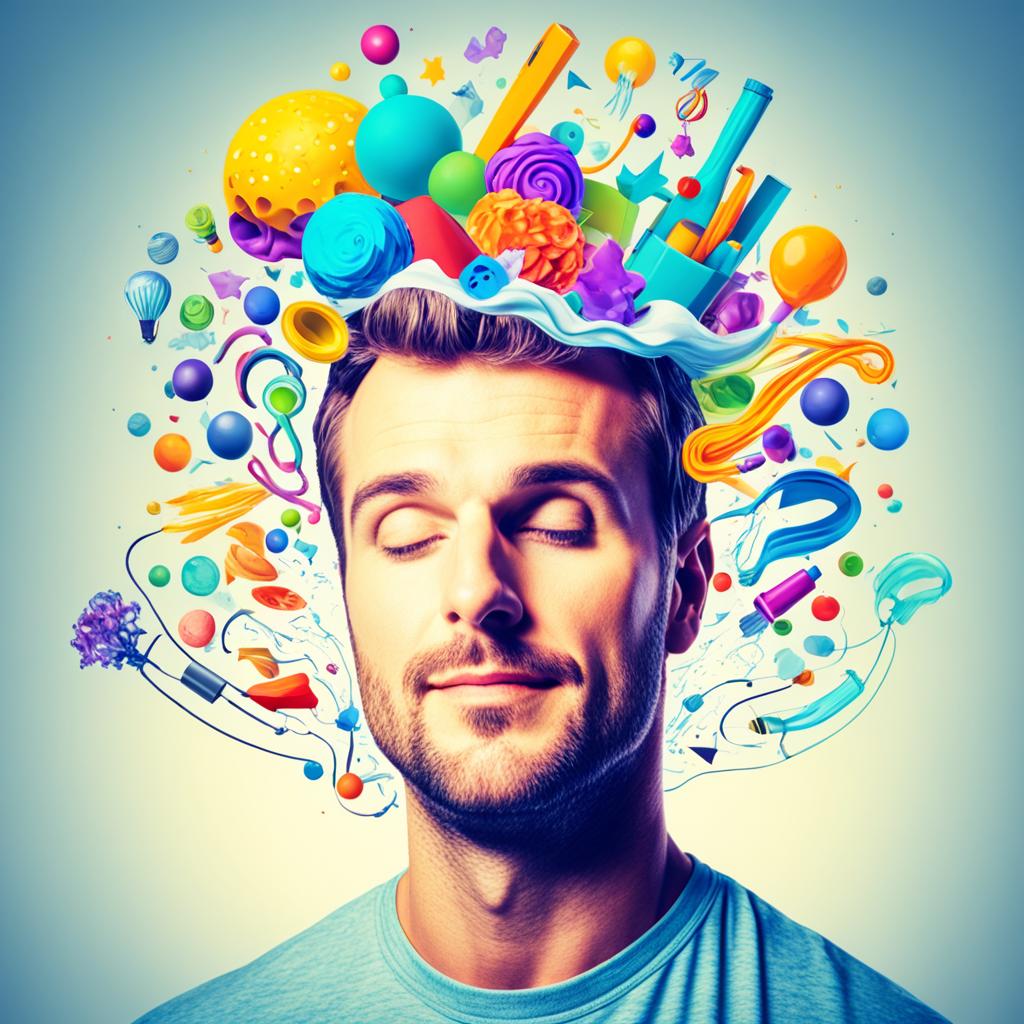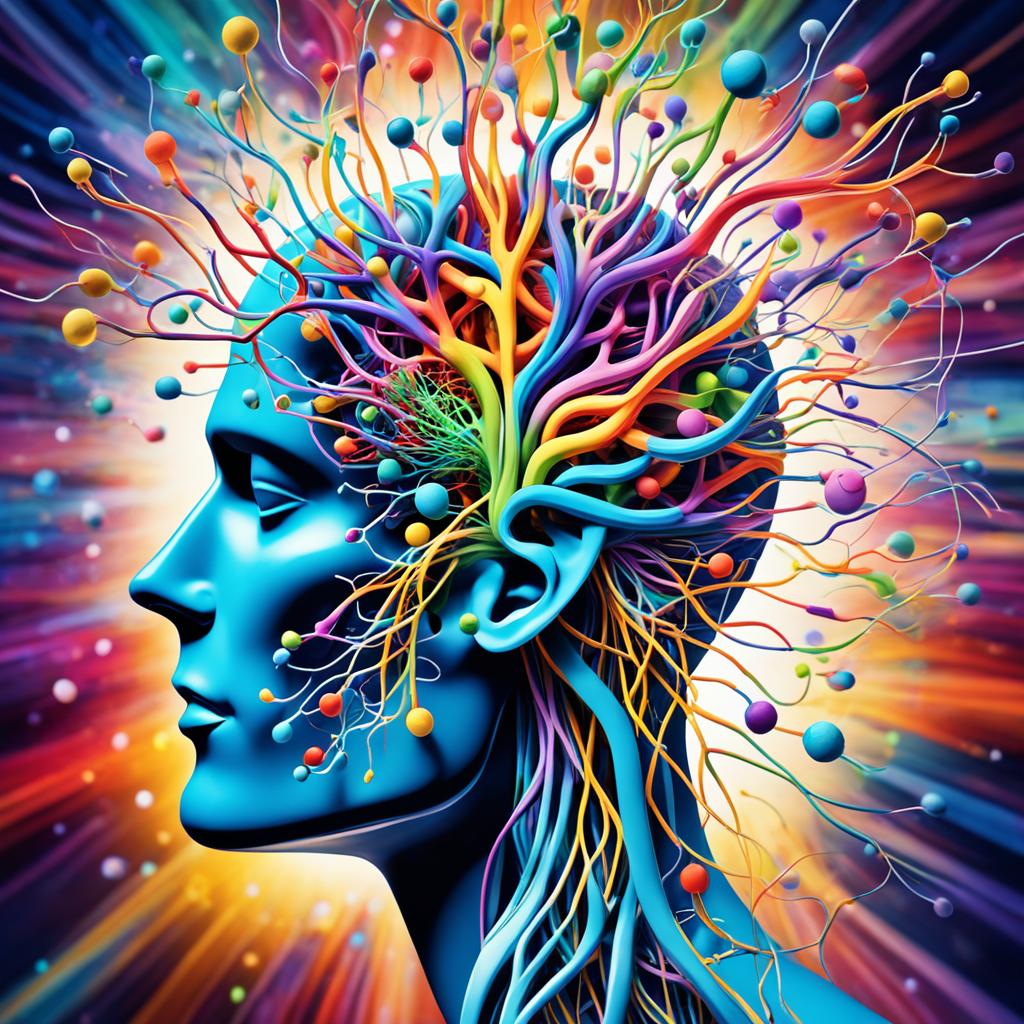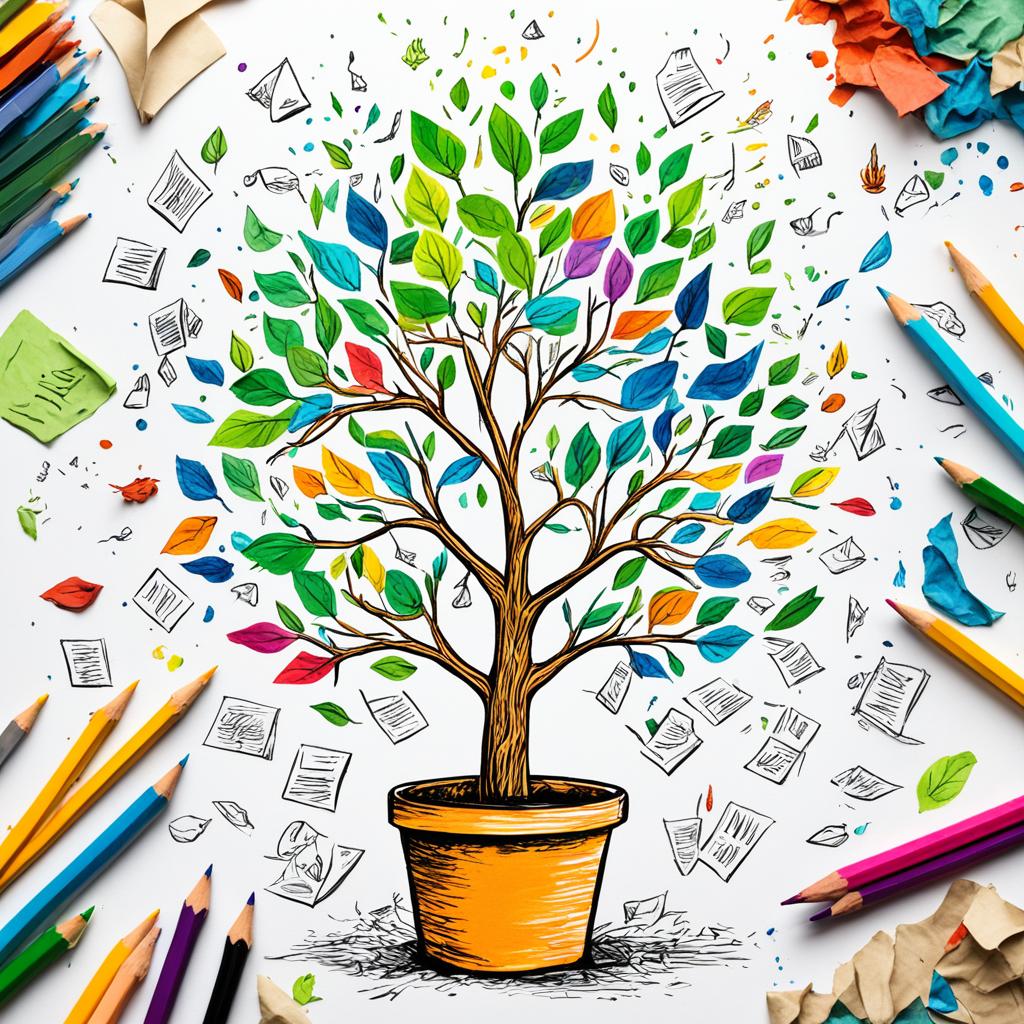Did you know that creativity is the most sought-after skill by employers? In fact, a survey conducted by IBM found that creativity is considered the most crucial quality for leaders to navigate an increasingly complex and uncertain world.
Whether you’re an artist, entrepreneur, or professional in any field, understanding the psychology of creativity can unlock your hidden potential and drive innovation and success. In this article, we will explore the power of creative thinking and provide actionable strategies to nurture your creative mindset.
The Importance of Creativity
Creativity is not just a quality reserved for artists and writers; it is a fundamental skill that plays a pivotal role in personal and professional growth. In an ever-evolving world, where innovation is the key to success, fostering creativity is more important than ever.
Creative individuals possess the ability to think outside the box, challenge norms, and come up with groundbreaking ideas. They are not limited by traditional thinking patterns and are willing to take risks to achieve innovative solutions. As such, creativity is closely linked to innovation, as it is the driving force behind problem-solving and pushing boundaries.
One of the significant advantages of creativity is its ability to adapt to change. In today’s rapidly changing landscape, adaptability is crucial, and creative thinkers excel in this aspect. They can quickly pivot, find alternative solutions, and thrive in uncertain situations.
Unlocking the Power of Creativity:
1. Embrace curiosity: Stay curious and question the status quo. Curiosity is the foundation of creativity and opens the doors to new possibilities.
2. Develop divergent thinking: Practice thinking divergently by exploring various perspectives and generating multiple ideas. This approach helps generate unique solutions.
3. Encourage risk-taking: Overcome the fear of failure and embrace calculated risks. Taking risks stimulates creativity by pushing you beyond your comfort zone.
4. Engage in interdisciplinary learning: Explore diverse fields of knowledge to broaden your understanding. The cross-pollination of ideas fosters innovation.
5. Surround yourself with diverse perspectives: Interact with individuals from different backgrounds and cultures. Exposing yourself to diverse perspectives sparks creativity.
“Creativity is not just about artistic expression; it is a mindset that enables us to see the world differently.” – Sir Ken Robinson
By nurturing creativity, you can unlock your full potential and become a catalyst for innovation. In an increasingly competitive landscape, individuals who can think creatively and bring fresh ideas to the table are highly sought after. Whether you are an entrepreneur, a professional, or a student, cultivating creativity will empower you to make a significant impact and thrive in any endeavor you pursue.


Continue reading to explore the inner workings of the creative mind and gain insights into how to unleash your creative genius.
Understanding the Creative Mind
When it comes to unraveling the mysteries of creativity, it is essential to explore the inner workings of the creative mind. The psychology of creativity delves into the various cognitive processes that underlie the generation of novel ideas and innovative solutions.
Divergent Thinking: Unleashing the Power of Possibilities
Divergent thinking is a key aspect of the creative mind. It involves the ability to generate multiple and diverse ideas, seeing beyond conventional boundaries. Unlike convergent thinking, which focuses on finding the single correct solution, divergent thinking encourages exploration and fosters the imaginative potential of the individual. By embracing divergent thinking, one can unlock greater creative capabilities and open doors to groundbreaking innovations.
Insight: The Eureka Moment
Insight, often referred to as the “eureka moment,” is a hallmark of creative thinking. It is the sudden realization or understanding that brings forth a solution or breakthrough idea. Insight can occur when the mind makes unexpected connections between seemingly unrelated concepts or when it perceives patterns or solutions that were previously hidden. Nurturing an environment conducive to insight is vital for enhancing creative problem-solving and innovation.
The creative mind is not bound by conventional limitations, but rather thrives on exploring uncharted territories, challenging assumptions, and pushing the boundaries of possibility. – Dr. Maya Mitchell, Cognitive Psychologist
The Role of Subconscious Processes
Beneath the surface of conscious thought lies the vast influence of subconscious processes on creativity. The subconscious mind continuously processes information, making unexpected connections and synthesizing ideas. It is during periods of relaxation, daydreaming, or engaging in mundane activities that the subconscious mind has the opportunity to actively contribute to the creative process. Learning to tap into the power of the subconscious can unlock a wealth of innovative ideas and perspectives.


The understanding of the creative mind is a complex and fascinating field of study. By exploring the various psychological aspects, such as divergent thinking, insight, and the role of subconscious processes, we gain invaluable insights into the mechanisms behind creativity. This knowledge forms the foundation for fostering our own creative potential and harnessing the power of innovative thinking.
Nurturing a Creative Mindset
Developing a creative mindset is essential for unlocking your full creative potential. By cultivating a mindset that embraces curiosity, resilience, and inspiration, you can enhance your creative thinking and innovation. Here are some actionable tips to nurture a creative mindset:
Embrace Curiosity
Creativity thrives on curiosity. Explore new ideas, topics, and perspectives to stimulate your imagination. Ask questions, seek knowledge, and challenge conventional thinking. Curiosity opens new pathways to innovative solutions and helps you think outside the box.
Build Resilience to Failure
Failure is an inherent part of the creative process. Embrace failures as learning opportunities rather than setbacks. Recognize that every failure brings you closer to success and allows for growth. Develop resilience by embracing a growth mindset and understanding that experimentation and iteration are essential for creative breakthroughs.
“Success is not final, failure is not fatal: It is the courage to continue that counts.” – Winston Churchill
Leverage Inspiration
Seek inspiration from various sources such as art, music, nature, and other creative individuals. Expose yourself to different ideas and experiences to fuel your imagination. Inspiration can spark innovative thinking and trigger unique connections that lead to creative solutions.
Remember, nurturing a creative mindset is an ongoing process. Continuously engage in activities that stimulate your curiosity, embrace failures as valuable learning experiences, and seek inspiration from the world around you. These strategies will help you develop a creative mindset that drives innovation and personal growth.


Breaking Through Creative Blocks
When it comes to creativity, we’ve all experienced those frustrating moments when our ideas seem to come to a screeching halt. Creative blocks can happen to anyone, from artists to entrepreneurs, and overcoming them is essential to tap into our full creative potential.
So, what causes these creative stagnations? There are various factors that can contribute to creative blocks, such as:
- Self-doubt: The fear of failure or judgment can stifle our creative thinking and prevent us from exploring new ideas.
- Perfectionism: The pursuit of perfection can create unrealistic expectations, making it harder to generate and execute innovative concepts.
- External pressures: Stress, deadlines, and other external factors can drain our creativity and hinder our ability to think outside the box.
However, the good news is that there are strategies to break through these barriers and reignite our creativity:
1. Embrace a Growth Mindset
Adopting a growth mindset allows us to view creative blocks as opportunities for growth and learning. Instead of seeing obstacles as roadblocks, we can see them as stepping stones to explore new possibilities.
2. Seek Inspiration
Surround yourself with inspiration from diverse sources. Explore different art forms, read books, watch movies, or engage in activities that spark your curiosity. Drawing inspiration from different disciplines can fuel your creativity and help you think outside the box.
3. Take Breaks
Often, creative blocks are a result of mental fatigue. Taking intentional breaks from your work allows your mind to recharge and refresh. Engage in activities that relax and rejuvenate you, such as going for a walk in nature or practicing mindfulness.
4. Experiment and Play
Allow yourself time and space to experiment and play without the pressure of achieving a specific outcome. Engaging in creative activities purely for enjoyment can lead to unexpected breakthroughs and new ideas.


“Creativity is allowing yourself to make mistakes. Art is knowing which ones to keep.” – Scott Adams
Remember, creativity is a process, and it’s natural to encounter obstacles along the way. By implementing these strategies and staying open to new experiences, you can overcome creative blocks and unlock your full creative potential.
The Role of Environment in Creativity
When it comes to creativity and innovative thinking, the environment we find ourselves in can have a profound impact on our ability to generate new ideas. The physical and social surroundings in which we operate can either stimulate or hinder our creative potential. Understanding the role of the environment in fostering creativity is essential for unlocking our full imaginative capabilities.
The Impact of Physical Environment
The physical environment plays a crucial role in nurturing creativity. This includes our workspace, home, or any other place where we spend a significant amount of time. Creating a conducive physical environment is essential for promoting creative thinking. A clutter-free and well-organized space can help clear our minds, reducing distractions and allowing us to focus on creative tasks.
In addition to tidiness, incorporating elements that inspire and stimulate creativity can be beneficial. Natural light, vibrant colors, and comfortable furniture can create a positive and energizing atmosphere that encourages innovative ideas. Similarly, personalizing our space with artwork, plants, or meaningful objects can evoke emotions and spark creative thinking.
The Power of Social Environment
Our social environment also greatly influences our creativity. Surrounding ourselves with like-minded individuals who value and prioritize creativity can provide support and inspiration. Engaging in discussions, brainstorming sessions, or collaborating with others can lead to diverse perspectives and fresh ideas. Interacting with individuals who challenge our thinking and push us outside our comfort zones can foster innovative thinking.
Furthermore, being part of a creative community or joining groups with shared interests can promote a sense of belonging and provide opportunities for collaboration and feedback. Creative communities often organize workshops, events, and discussions that expose individuals to new ideas and encourage experimentation.
“Surrounding ourselves with individuals who value and prioritize creativity can ignite our own creative thinking.” – Jane Johnson, Creative Director
Tapping into Creativity-Enhancing Environments
Creating a conducive environment for creativity goes beyond physical and social aspects. It also involves intentionally seeking out new experiences, exposing ourselves to different cultures, and exploring novel environments. Traveling, visiting museums, or simply taking a different route to work can expose us to new stimuli and broaden our perspectives.
Moreover, incorporating elements of play and relaxation in our daily lives can help foster the mindset needed for creative thinking. Engaging in hobbies, leisure activities, or simply taking breaks to recharge can free our minds and allow innovative ideas to surface.


In essence, the role of the environment in creativity cannot be understated. By creating a physical and social environment that supports and nurtures innovation, we can unlock our creative potential and achieve breakthroughs. Remember, every detail in our environment matters, from the colors on the walls to the people we surround ourselves with. Embrace the power of environment and unleash your creativity.
- Design a workspace that is clean, organized, and inspiring
- Surround yourself with like-minded individuals and join creative communities
- Expose yourself to new experiences and diverse environments
- Incorporate play and relaxation into your daily routine
Enhancing Creativity through Collaboration
Collaboration has the power to ignite creativity and foster innovation. By bringing together diverse perspectives, skills, and experiences, teams can generate groundbreaking ideas that may not have been possible individually. Through collaboration, individuals have the opportunity to pool their collective knowledge and creatively problem-solve, leading to new and innovative solutions.
One of the key benefits of collaboration is the exchange and cross-pollination of ideas. When individuals with different backgrounds and areas of expertise come together, they bring unique insights and approaches to the table. This diversity of thought sparks creativity and encourages thinking beyond traditional boundaries.
Collaboration also provides a supportive environment that nurtures creativity. Working with others who share a common purpose and passion for innovation creates a sense of momentum and inspiration. Through open dialogue and constructive feedback, team members can refine and enhance their ideas, pushing the boundaries of what is possible.
Furthermore, collaboration promotes a culture of shared accountability and responsibility. When individuals collaborate, they are invested in the success of the collective outcome. This shared commitment motivates team members to contribute their best ideas and to challenge and inspire one another along the creative process. The synergy created through collaboration amplifies the potential for innovative thinking and problem-solving.
“Alone, we can do so little; together, we can do so much.” – Helen Keller
Benefits of Collaboration:
- Increased creativity and innovation.
- Access to diverse perspectives and expertise.
- Enhanced problem-solving abilities.
- Spark for inspiration and motivation.
- Shared responsibility and accountability.
Collaboration is not limited to physical proximity or a specific industry. In today’s interconnected world, technology has made it easier than ever to collaborate across distances and disciplines. Virtual collaborations, online platforms, and remote team setups enable individuals to connect and collaborate globally, transcending geographical and organizational boundaries. Through these modern collaborative approaches, innovation can thrive regardless of constraints.
The Power of Mindfulness in Creativity
Mindfulness practices have become increasingly popular in recent years, not only for their benefits in reducing stress and promoting overall well-being, but also for their remarkable effects on enhancing creativity. By incorporating mindfulness techniques into our daily lives, we can unlock new levels of creative thinking and innovation.
One of the key ways mindfulness enhances creativity is by fostering focus and concentration. When we practice mindfulness, we train our minds to stay present and engaged in the current moment. This heightened sense of focus allows us to fully immerse ourselves in our creative endeavors, enabling us to generate new ideas and think outside the box.
In addition to focus, mindfulness also promotes clarity of mind. By cultivating a clear and calm state of mind through mindfulness meditation or mindfulness exercises, we can declutter our thoughts and gain mental clarity. This mental clarity provides a fertile ground for creative thinking, allowing us to see connections, patterns, and possibilities that may have eluded us before.
Furthermore, mindfulness encourages open-mindedness and curiosity. When we approach our creative pursuits with a non-judgmental and open attitude, we become more receptive to unconventional ideas and perspectives. This expansive mindset enables us to explore alternative solutions and think creatively, ultimately fueling innovation.
The Benefits of Mindfulness in Creativity:
- Enhanced focus and concentration
- Increased clarity of mind
- Promotion of open-mindedness and curiosity
- Stress reduction and increased mental well-being
- Cultivation of a positive mindset
“Mindfulness is the gateway to creativity. By bringing our attention to the present moment, we unlock the potential of our creative minds.” – Jon Kabat-Zinn
Incorporating mindfulness practices into our creative routines can have a profound impact on our ability to generate innovative ideas and think creatively. Whether it’s through meditation, breathing exercises, or simply taking moments of mindful awareness throughout the day, we can tap into the power of mindfulness to unlock our creative potential.
Tapping into Personal Motivation for Creativity
Motivation is the driving force behind creative endeavors. Understanding how to tap into personal motivation can unlock your full creative potential and fuel innovation. In this section, we will explore different types of motivation and provide strategies to harness them for greater creativity and creative thinking.
Types of Motivation
There are two main types of motivation: extrinsic and intrinsic. Extrinsic motivation comes from external rewards or recognition, such as money, fame, or praise from others. Intrinsic motivation, on the other hand, stems from internal satisfaction, enjoyment, and personal fulfillment.
- Extrinsic motivation: While external rewards can initially spark creativity, relying solely on extrinsic motivation may lead to shallow and short-lived creative output.
- Intrinsic motivation: Cultivating intrinsic motivation fosters a deep sense of passion and purpose, resulting in sustainable creativity and innovative ideas.
To tap into personal motivation for creativity, it is important to find a balance between extrinsic and intrinsic factors. While external recognition can be motivating, it is essential to cultivate a deep personal drive and passion for the creative process itself.
Strategies for Harnessing Personal Motivation
Here are some strategies to help you tap into your personal motivation and fuel your creativity:
- Define your purpose: Reflect on why creativity is important to you. Identify the impact you want to make through your creative work. Understanding your purpose can provide a sense of direction and intrinsic motivation.
- Set meaningful goals: Establish specific, measurable, achievable, relevant, and time-bound (SMART) goals for your creative projects. Breaking down larger goals into smaller milestones can help maintain motivation and provide a sense of accomplishment along the way.
- Cultivate a growth mindset: Embrace challenges, learn from failures, and view obstacles as opportunities for growth. Adopting a growth mindset fosters resilience, determination, and an eagerness to explore new ideas.
- Find inspiration: Seek inspiration from various sources, such as books, art, nature, or conversations with others. Surrounding yourself with diverse stimuli can spark new ideas and ignite your creative drive.
- Create a supportive environment: Surround yourself with individuals who share your passion for creativity. Collaborate with like-minded peers, join creative communities, and engage in constructive feedback to fuel your motivation and broaden your perspectives.
Remember, motivation is not a constant state, but rather a fluctuating force. It is important to continuously nurture and tap into your personal motivation to sustain your creativity and drive innovation.
Overcoming Creative Self-Doubt
Self-doubt can be a formidable obstacle to unlocking your full creative potential. When you doubt your abilities and ideas, it can hinder your progress and stifle innovative thinking. However, there are effective techniques you can employ to overcome creative self-doubt and cultivate the confidence necessary to unleash your creative genius.
Embrace Your Unique Perspective
- Recognize your strengths: Reflect on your past creative successes and acknowledge the unique qualities and skills that contribute to your creative endeavors.
- Acknowledge your perspective: Understand that your perspective is valuable and brings a fresh and unique viewpoint to your creative work. Embrace the diversity your thoughts and ideas offer.
- Seek validation: Share your ideas with a trusted friend or mentor who can provide constructive feedback and reassurance. Sometimes an external perspective can help you see the value in your own creativity.
Challenge Negative Thoughts
“Whether you think you can or you think you can’t, you’re right.” – Henry Ford
Be mindful of the negative thoughts that may arise when self-doubt creeps in. Challenge these thoughts with positive affirmations and remind yourself of past creative accomplishments. Replace self-criticism with self-compassion and allow yourself to experiment and learn from any perceived failures or setbacks.
Cultivate a Supportive Environment
Surrounding yourself with like-minded individuals who understand the creative process can provide the encouragement and support needed to overcome self-doubt. Engage in creative communities, join workshops, or seek out mentors who can offer guidance and motivation. Collaboration and shared experiences can inspire confidence and foster a sense of belonging.
Practice Self-Care
Take care of your physical, mental, and emotional well-being to combat self-doubt. Prioritize self-care activities such as exercise, meditation, and mindfulness practices. These activities can help you relax, reduce stress, and quiet your inner critic, allowing you to approach your creative endeavors with a clearer and more confident mindset.
By implementing these techniques, you can overcome creative self-doubt and build the confidence necessary to express your innovative ideas. Embrace your unique perspective, challenge negative thoughts, cultivate a supportive environment, and practice self-care. With a positive and self-assured mindset, your creativity can flourish, leading to groundbreaking innovation and personal growth.
Fostering a Creative Lifestyle
Creativity is not limited to specific tasks; it can be cultivated as a lifestyle. Embracing creativity in everyday life can lead to continuous innovation and personal growth. By adopting habits and routines that foster creative thinking, individuals can tap into their creative potential and apply it to various aspects of their lives.
One way to foster a creative lifestyle is by seeking inspiration from diverse sources. Exploring different art forms, literature, music, and even nature can spark fresh ideas and ignite imaginative thinking. Taking the time to appreciate the beauty and intricacies of the world around us can fuel creativity and bring a new perspective to problem-solving.
Another important aspect of a creative lifestyle is the cultivation of curiosity. By asking questions, exploring new subjects, and seeking knowledge, individuals can expand their understanding and fuel their imagination. Curiosity allows for exploration of different possibilities and encourages innovative thinking.
Creating a conducive environment is key to nurturing a creative mindset. Designating a dedicated space for creativity, whether it’s a home studio, a quiet corner, or a digital workspace, helps eliminate distractions and promotes focus. Surrounding oneself with inspiring artwork, quotes, or objects can serve as reminders to think outside the box and embrace creative thinking.
Collaboration with like-minded individuals is also instrumental in fostering a creative lifestyle. By engaging in brainstorming sessions, workshops, or joining creative communities, individuals can gain new perspectives, exchange ideas, and receive valuable feedback. Collaboration not only fuels creativity but also enhances innovation through the synergy of diverse talents and expertise.
Embracing creativity as a lifestyle entails a mindset shift. It involves embracing uncertainty, embracing failure as an opportunity for growth, and being open to unconventional ideas. It’s about challenging the status quo and continuously pushing the boundaries of what is possible.
Lastly, a creative lifestyle thrives on a balance between introspection and action. Taking the time for self-reflection and introspection allows individuals to understand their creative strengths and areas of growth. By setting goals and taking consistent action, individuals can translate their creative ideas into tangible outcomes and bring their innovative visions to life.
By fostering a creative lifestyle, individuals can unlock their full creative potential and infuse creativity into all aspects of their lives. Embracing creativity as a way of life enables continuous growth, promotes innovation, and fosters a sense of fulfillment and purpose.
Conclusion
In conclusion, understanding the psychology of creativity is crucial for unleashing your inner genius and driving innovation. Creativity serves as the foundation for personal and professional growth, allowing you to think outside the box and find solutions to complex problems. By nurturing a creative mindset and breaking through creative blocks, you can tap into your full creative potential.
The role of environment and collaboration cannot be underestimated in fostering creativity. Creating an environment that encourages innovation and surrounding yourself with like-minded individuals can inspire and motivate you to think creatively. Collaboration, on the other hand, brings together diverse perspectives and ideas, leading to breakthrough innovations.
Additionally, incorporating mindfulness practices and tapping into personal motivation can further enhance creative thinking. Mindfulness promotes focus and open-mindedness, enabling you to explore new possibilities. Finding personal motivation ensures that you stay driven and passionate about your creative endeavors.
By overcoming self-doubt and embracing creativity as a lifestyle, you can continuously unlock your creative potential and achieve personal success. Remember, creativity is not limited to specific tasks or professions; it is a mindset that can be cultivated and applied in all aspects of life. So, dare to think creatively, embrace innovation, and watch your creativity flourish.
